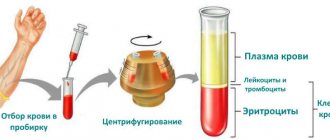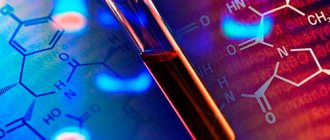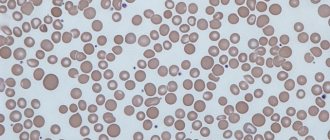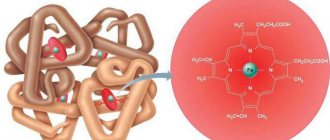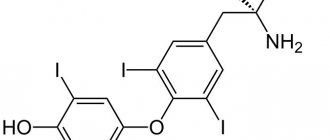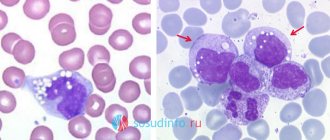Albumin is produced by the liver. Therefore, it is natural when, with elevated protein, a doctor suspects liver dysfunction in a patient. But the causes of the malaise may also be hidden in other pathologies. The doctor’s task is to prescribe the necessary types of examination, establish an accurate diagnosis and help the patient lower albumin.
Microalbuminuria - what is it?
Albumin is a type of protein that circulates in human blood plasma. It performs a transport function in the body, responsible for stabilizing fluid pressure in the bloodstream. Normally, it can enter the urine in symbolic quantities, in contrast to protein fractions that are heavier in molecular weight (they should not be present in urine at all).
This is due to the fact that the size of albumin molecules is smaller and closer to the diameter of the pores of the kidney membrane.
In other words, even when the blood-filtering “sieve” (the glomerular membrane) is not yet damaged, but there is an increase in pressure in the glomerular capillaries or the control of the “throughput” of the kidneys changes, the concentration of albumin increases sharply and significantly. At the same time, no other proteins are observed in the urine even in trace concentrations.
This phenomenon is called microalbuminuria - the appearance of albumin in the urine in a concentration exceeding the norm in the absence of other types of protein.
This is an intermediate state between normoalbuminuria and minimal proteinuria (when albumin is combined with other proteins and is determined using total protein tests).
The result of the MAU analysis is an early marker of changes in the renal tissue and allows making predictions about the condition of patients with arterial hypertension.
Protein Features
Albumin is a protein that is produced in the liver. Its amount in the blood is about 60% of all proteins in the body, and its structure allows it to perform many different functions. Albumin prevents blood from leaking out of blood vessels and nourishes tissues. Another important characteristic of a protein is its transport function. It transports hormones, vitamins, medications, calcium and other substances throughout the human body.
Albumin levels may decrease to varying degrees when they are interfered with by various liver dysfunctions, increased protein breakdown, protein loss through the kidneys, and/or increased blood plasma volume (i.e., the blood becomes thinner). It is customary to distinguish two main reasons for a decrease in albumin in the blood:
- Severe liver diseases. Since albumin is produced in the liver, its levels may decrease as this organ declines in function. But this is usually observed only in severe cases.
- Kidney disease. One of the many functions of the organ is to maintain the level of protein in the blood, which includes albumin.
Albumin should not be excreted from the body along with other breakdown products during the formation of urine in the kidneys. It is a component of blood plasma, and therefore must remain at the same level when the blood is filtered by the kidneys. But if a patient's kidneys become damaged, albumin and other proteins begin to pass through the filters through enlarged holes - and then proteins are found in the urine. This often occurs during chronic disorders such as diabetes and hypertension. In nephrotic syndrome, very large amounts of albumin are lost through the kidneys, and accordingly, the amount of protein in the blood decreases.
What does a general blood test show during pregnancy? 303528
Microalbumin norm indicators
To determine albumin in urine at home, test strips are used to give a semi-quantitative assessment of the protein concentration in urine. The main indication for their use is that the patient belongs to risk groups: the presence of diabetes mellitus or arterial hypertension.
The strip test scale has six gradations:
- “not determined”;
- “trace concentration” – up to 150 mg/l;
- “microalbuminuria” – up to 300 mg/l;
- “macroalbuminuria” – 1000 mg/l;
- “proteinuria” – 2000 mg/l;
- “proteinuria” – more than 2000 mg/l;
If the screening result is negative or “traces”, then in the future it is recommended to periodically conduct research using test strips.
If the urine screening result is positive (value 300 mg/l), confirmation of the pathological concentration using laboratory tests will be required.
The materials for the latter can be:
- a single (morning) portion of urine is not the most accurate option, due to the presence of variations in protein excretion in the urine at different times of the day, it is convenient for screening studies;
- a daily portion of urine is appropriate if monitoring of therapy or in-depth diagnostics is necessary.
The result of the study in the first case will be only the albumin concentration, in the second the daily protein excretion will be added.
In some cases, the albumin/creatinine indicator is determined, which allows for greater accuracy when taking a single (random) portion of urine. Adjustment for creatinine level eliminates the distortion of the result due to uneven drinking regime.
The standards for MAU analysis are given in the table:
| Albumin release per day | Albumin/Creatinine | Concentration in the morning portion | |
| Norm | 30 mg/day | 17 mg/g (men) 25 mg/g (women) or 2.5 mg/mmol (men) 3.5 mg/mmol (women) | 30 mg/l |
In children, there should be practically no albumin in the urine; it is also physiologically justified to lower its level in pregnant women compared to previous results (without any signs of malaise).
Why is the level of albumin in the blood elevated and how to stabilize it
Albumin standard for patients of different age groups
Albumin is determined based on the standards recorded for people of different ages:
- When it comes to children 14 years old, the normal level of protein in blood plasma ranges from 38 to 54 g/l.
- For patients from 14 to 60 years of age, the indicator slightly changes the permissible values and ranges from 35 to 50 g/l.
- For elderly patients, the norm is from 34 to 48 g/l albumin in the blood.
Why does albumin increase?
The amount of protein increases in the following cases:
- When the body experiences dehydration. This is how the immune system tries to protect itself from intoxication with accompanying prolonged diarrhea and vomiting.
- Elevated albumin is also detected in a blood test in pregnant women.
- Cause fluctuations in the flu state.
- Anyone who neglects a healthy lifestyle will at least once encounter abnormal values of this type of protein.
- Oncology.
Methods for diagnosing elevated albumin
Suspecting a patient has certain diseases, the doctor prescribes testing to determine the amount of albumin.
Albumin is low or high in the blood, determined by blood biochemistry. Testing is carried out taking into account certain rules:
In healthy people, albumin is excreted in urine in a volume of 30 mg per day. Exceeding this indicator indicates disturbances in the functioning of the cardiovascular system and vascular atherosclerosis. Those diagnosed with diabetes mellitus and chronic renal dysfunction show a tendency to protein inconsistency with standard indicators.
Consequences of elevated protein levels
Microalbuminuria is often diagnosed, but elevated protein is rare. If the excess of standard values is small, we can talk about excessive physical activity of a person on the eve of testing. However, such violations are also possible with the following ailments:
- the patient has cholera,
- suffers from diabetes mellitus,
- suffers from intestinal obstruction,
- lupus erythematosus.
If a person has at least once been diagnosed with elevated protein in the urine or blood, he should undergo regular examinations and adjust albumin values. This approach helps to avoid health-threatening complications.
Traditional recipes for lowering albumin
Albumin itself never increases; it is only a symptom of an unhealthy lifestyle, poor nutrition, and improper distribution of physical activity. Alcoholics, those who smoke, and people susceptible to viral infections constantly suffer from increased protein.
To smooth out unpleasant symptoms and stabilize your health, it is recommended to prepare a liver mixture. There is no need to prepare herbs yourself; it is sold in every pharmacy and is inexpensive. How is the collection brewed?
- Measure out 1 level teaspoon of herb.
- Pour 250 ml of boiling water. You can put it in a thermos or an enamel pan.
- Wrap the container in a blanket.
- Wait for the liquid to cool completely.
- Strain the infusion through several layers of gauze and drink half an hour before meals. 250 ml is a single dosage; you need to brew a new portion of healing tea each time.
Doctors say the advantage of liver collection is the absence of side effects. Also drink more water and if you have persistent diarrhea, take Loperamide. While taking Loperamide, stick to your diet, and when it becomes easier, gradually move on to a more difficult to digest dish. Otherwise, intestinal obstruction may occur. If persistent vomiting is tormented, it is unlikely that you will be able to stop it on your own. Call an ambulance.
What foods increase albumin?
- beef meat,
- chicken egg, regardless of cooking method,
- dried mushrooms,
- cottage cheese in its pure form, cheesecakes with cottage cheese, casseroles, pies,
- potato,
- legumes,
- cod fish,
- seafood,
- hard cheese.
As you can see, the list of foods that can increase albumin is quite long. Some avoid drug treatment and independently decide to switch to dietary nutrition. But the result is the opposite - the body starves, but the problem is not solved, and even worsens. To reduce the protein level, you need to cure the disease or at least achieve remission. Do not experiment with your health, seek help from specialists!
Source: obanalizekrovi.ru
Source: sosud.neboleite.com
Decoding analysis data
Depending on the quantitative content of albumin, three types of possible patient’s condition can be distinguished, which can be conveniently summarized in a table:
| Daily albumin | Albumin/creatinine | Albumin/creatinine | |
| Norm | 30 mg/day | 25 mg/g | 3 mg/mmol |
| Microalbuminuria | 30-300 mg/day | 25-300 mg/g | 3-30 mg/mmol |
| Macroalbuminuria | 300 or more mg/day | 300 or more mg/g | 30 or more mg/mmol |
An analysis indicator called the rate of albumin excretion in urine is also sometimes used, which is determined over a certain time interval or per day. Its meanings are deciphered as follows:
- 20 mcg/min – normoalbuminuria;
- 20-199 mcg/min – microalbuminuria;
- 200 or more – macroalbuminuria.
These numbers can be interpreted as follows:
- the current normal threshold may be lowered in the future. The basis for this is research concerning an increased risk of cardiovascular and vascular pathologies already at an excretion rate of 4.8 mcg/min (or from 5 to 20 mcg/min). From this we can conclude that screening and quantitative tests should not be neglected, even if a one-time test did not show microalbuminuria. This is especially important for people with non-pathological high blood pressure;
- If a microconcentration of albumin is detected in the blood, but there is no diagnosis that would classify the patient as a risk group, it is advisable to provide a diagnosis. Its goal is to exclude the presence of diabetes mellitus or hypertension;
- if microalbuminuria occurs against the background of diabetes or hypertension, it is necessary to bring the recommended values of cholesterol, blood pressure, triglycerides and glycated hemoglobin using therapy. A set of such measures can reduce the risk of death by 50%;
- if macroalbuminuria is diagnosed, it is advisable to analyze the content of heavy proteins and determine the type of proteinuria, which indicates severe kidney damage.
Diagnosis of microalbuminuria has great clinical value if there is not one test result, but several, done at intervals of 3-6 months. They allow the doctor to determine the dynamics of changes occurring in the kidneys and cardiovascular system (as well as the effectiveness of the prescribed therapy).
How is the albumin test used?
An albumin test is usually performed on a sample of the patient's blood and urine. Albumin in the blood is determined using tests to diagnose two categories of diseases: the liver, in which it is produced, and the kidneys, in which it can leak out when they are dysfunctional. In addition, blood albumin tests show how well the patient is eating and are also tested before surgery.
An albumin test is usually included in a general panel of tests that are carried out as part of a general examination of the patient's health. These include a comprehensive metabolic panel and biochemical tests. Because albumin can be low in the blood in numerous diseases and disorders, it is often prescribed to help a doctor diagnose a disease, monitor changes in a patient's condition, and the body's response to treatment.
In addition to extensive biochemistry tests, albumin testing is part of the liver panel, which is prescribed to assess liver function. Another group of tests that this study includes is a renal panel to assess kidney function. The main tests of this panel are creatinine and uric acid tests.
Causes of high albumin levels
In some cases, a single study can reveal an increase in albumin due to physiological reasons:
- predominantly protein diet;
- physical and emotional overload;
- pregnancy;
- violation of the drinking regime, dehydration;
- taking non-steroidal anti-inflammatory drugs;
- elderly age;
- overheating or vice versa, hypothermia of the body;
- excess nicotine entering the body when smoking;
- critical days for women;
- racial characteristics.
If changes in concentration are associated with the listed conditions, then the test result may be considered false positive and uninformative for diagnosis. In such cases, it is necessary to ensure correct preparation and submit the biomaterial again after three days.
Why does serum albumin increase?
Often, deviations in protein levels from the norm arise from non-compliance with the rules for preparing for blood donation. If you have hyperalbuminemia, your doctor may order a repeat test to confirm the results. In order for them to be accurate, the following rules must be observed:
- Blood is taken from a vein on an empty stomach. You should not eat or drink in the morning before the test.
- You need to tell the doctor about the medications you are taking. Your doctor may recommend lowering your dose or stopping taking the drug.
- 12 hours before the test, you need to eliminate caffeine, nicotine, and alcohol.
- It is important to avoid intense physical and psycho-emotional stress a couple of days before the test.
Dehydration
Changes in albumin levels during pregnancy
Pregnant women are characterized by a decrease in albumin levels. This condition is called hypoalbuminemia. It develops due to the increased need of a pregnant woman for protein fractions. The woman’s body provides them to the fetus inside the womb.
The albumin fraction contains a supply of essential amino acids that the child needs. During pregnancy, its concentration gradually decreases. The lowest level is diagnosed in the last trimester. More often, protein concentration in pregnant women changes as follows:
- First trimester – decreases to 32 g/l.
- The second one is reduced to 28 g/l.
- Almost before birth it is at the level of 25 g/l.
Diseases of internal organs
Hepatocytes - liver cells - are responsible for the production of albumin, as well as C-reactive protein. Changes in protein levels are often associated with liver disease. They are the leading cause of hyperalbuminemia. Protein levels also depend on the condition of the kidneys, cardiovascular and digestive systems. Possible reasons for its increase:
- nephritis;
- intestinal obstruction;
- cirrhosis of the liver;
- hepatitis of various etiologies;
- kidney diseases that cause increased fluid excretion.
Blood pathologies and metabolic disorders
An increase in albumin concentration can be observed when the blood thickens. Another risk factor is myeloma, a malignant tumor of plasma cells. Increased albumin in the blood is associated with metabolic disorders, such as diabetes.
How to prepare for a daily UIA
This type of examination provides the greatest accuracy, but will require the implementation of simple recommendations:
- the day before the collection and during it, avoid taking diuretics, as well as antihypertensive drugs of the ACE inhibitor group (in general, taking any medications should be discussed with your doctor in advance);
- the day before urine collection, you should avoid stressful and emotionally difficult situations, intense physical training;
- at least two days in advance, stop drinking alcohol, energy drinks, and, if possible, smoking;
- maintain a drinking regime and do not overload the body with protein foods;
- The test should not be performed during non-infectious inflammation or infection, as well as critical days (in women);
- the day before collection, avoid sexual contact (for men).
Possible complications
If the albumin level is very abnormal, a person may face various complications if not treated in a timely manner. Most often, against the background of such a disorder, a metabolic failure occurs and jumps in blood pressure appear.
A person suffering from the pathology feels tired and “broken” all the time, and he may also experience disturbances in the functioning of the gastrointestinal tract.
To prevent complications, you need to do a blood test at least once a year. This preventive measure will help to identify deviations in a timely manner and, if necessary, begin therapy.
All materials are published under the authorship or editorship of medical professionals (about the authors), but are not a prescription for treatment. Contact the specialists!
When using materials, a link or indication of the source name is required.
Author: Z. Nelly Vladimirovna, laboratory diagnostics doctor, Research Institute of Transfusiology and Medical Biotechnology
The main plasma protein, albumin, is considered the main protein in the blood, accounting for up to 60% of all available proteins and having a very important functional purpose.
Synthesized by hepatocytes (liver parenchyma cells), the albumin fraction is busy solving important tasks every minute. It ensures the constancy of the BCC (circulating blood volume), regulates the oncotic or, as it is also called, colloid-osmotic, pressure of the liquid part of the blood, and is responsible for the binding, transfer and deposition of many substances vital to the body into reserve.
The expression most often used in relation to this fraction is “serum albumin” (this is the most famous of albumins). And he is not some special protein. This is the same albumin present in the blood (plasma, serum) and, in addition, in some other body fluids, for example, in the cerebrospinal fluid, therefore, in further descriptions of this protein, this name may also appear (serum albumin).
How to take the test correctly
Collecting daily biomaterial is a little more difficult than a single portion, which is why it is preferable to do everything carefully, minimizing the possibility of distorting the result. The sequence of actions should be as follows:
- It is worth collecting urine in such a way as to ensure its delivery to the laboratory the next day, observing the collection interval (24 hours). For example, collecting urine from 8.00 a.m. to 8.00 a.m.
- Prepare two sterile containers – small and large.
- Immediately after waking up, empty your bladder without collecting urine.
- Take care of the hygienic condition of the external genitalia.
- Now, during each urination, you need to collect the excreted liquid in a small container and pour it into a large one. The latter should be stored strictly in the refrigerator.
- The time of the first urine output for collection purposes must be recorded.
- The last portion of urine should be collected the next morning.
- Ahead of the volume of liquid in a large container, write down the directions on the form.
- Mix the urine thoroughly and pour about 50 ml into a small container.
- Don’t forget to note your height and weight on the form, as well as the time of your first urination.
- Now you can take a small container with biomaterial and send it to the laboratory.
If a single portion is taken (screening test), then the rules are similar to taking a general urine test.
Testing for microalbuminuria is a painless method for early diagnosis of heart disease and related renal disorders. It will help to recognize a dangerous trend even when there are no diagnoses of “hypertension” or “diabetes mellitus” or their slightest symptoms.
Timely therapy will help prevent the development of future pathology or alleviate the course of an existing one and reduce the risk of complications.
Microalbuminuria
- a laboratory symptom accompanied by the appearance of traces of low molecular weight proteins in urine - up to 0.3 grams per liter per day. Such loss cannot be determined using a screening test - a general clinical urine test. To detect microalbuminuria, the laboratory technician uses highly sensitive tests.
Normally, the glomerular epithelium does not allow protein molecules to pass through. With minor disturbances, it becomes permeable to albumin. These proteins have a very low molecular weight, so they are able to leak through the glomerular membrane of the kidneys. Diseases accompanied by microalbuminuria include diabetes mellitus, arterial hypertension, autoimmune and inflammatory pathologies.
Increased albumin
The site provides reference information for informational purposes only. Diagnosis and treatment of diseases must be carried out under the supervision of a specialist. All drugs have contraindications. Consultation with a specialist is required!
It is one of the main proteins in human blood and is produced in the liver. From the point of view of classification, albumins are aggregate formations called protein fractions. When performing a blood test for biochemistry, it is combinations of fractions that can help make the correct diagnosis. An analysis of the level of this substance is used in cases of suspected kidney and liver diseases, as well as malignant neoplasms and rheumatic processes.
The norm of this substance for children under fourteen years of age is from thirty-eight to fifty-four grams per liter of blood. For patients from fourteen to sixty years of age, this figure is from thirty-five to fifty grams per liter of blood, and for people over the age of sixty years, the normal albumin level is from thirty-four to forty-eight grams per liter.
An increase in the level of this substance indicates blood thickening. That too much fluid is being removed from the body or that too little is being taken in. Much more dangerous is a decrease in the level of this substance in the blood.
Sometimes this can be almost the norm if we are talking about a woman carrying a fetus or a breastfeeding mother. In addition, the albumin level is always a little short for those who abuse nicotine. But a reduced level of this substance can also indicate the presence of rather unpleasant diseases in the body, for example, these can be severe and chronic liver diseases (cirrhosis, neoplasms, hepatitis). The level of this substance is also reduced in case of problems with the intestines, in case of any purulent phenomena in the body. Its level is less than normal in those patients who suffer from rheumatism or cancer.
Author: Pashkov M.K. Content Project Coordinator.
Causes
Albumin
- blood plasma proteins with low molecular weight. Kidney filters should not allow them to pass into the urine. The initial stages of many vascular pathologies are accompanied by the loss of albumin in urine. Severe structural disorders of the renal glomeruli are characterized by the excretion of larger proteins in the urine.
Normally, the glomerular membrane has “pores” through which unnecessary substances leak. Albumin can penetrate through such holes. However, the glomerular membrane and the protein molecule have a negative charge, so they repel each other. Due to the described mechanism, albumins do not enter the urine.
The main cause of impaired protein transport in the renal glomeruli is vascular pathologies. They can be caused by various factors, but the essence of the problem comes down to the appearance of a positive charge on the glomerular membrane. Due to the described disorder, albumin molecules are attracted to the epithelium and leak through the “pores” into the urine.
Another common cause of increased albumin in the urine is acute and chronic glomerulonephritis. The pathology is accompanied by the synthesis of antibodies to the glomerular epithelium of the kidneys. They destroy the small vessels of the organ, causing a change in the charge of the membrane. Most often, this disease occurs in children and young women.
Microalbuminuria can also occur against the background of pyelonephritis and other nephropathies. Laboratory syndrome is not typical for mild variants of the pathology. However, it appears with chronic inflammation of the connective tissue of the kidneys and the process transfers to the glomeruli.
Glomerulosclerosis is the final stage of chronic glomerulonephritis and other kidney pathologies. This diagnosis is made when normal organ cells are replaced by connective tissue. In the early stages, glomerulosclerosis is often accompanied by the release of albumin in the urine.
An increase in albumin in urine is observed with gestational arterial hypertension - late gestosis. The described complication of pregnancy is accompanied by the appearance of protein in the urine, edema and an increase in blood pressure.
Transient decrease in protein levels
All of the above conditions, when albumin is low, are characterized by their duration. Most of them require long-term treatment. But there are cases when the protein level decreases briefly and quickly returns to normal after the cause is eliminated. In these conditions, a decrease in albumin is associated with increased breakdown. Such diseases include:
- acute and chronic infectious diseases;
- large blood loss;
- serious injuries;
- large area burns;
- inflammatory diseases of the skin;
- extensive wounds;
- heart failure with the development of edema;
- decreased oxygen supply to tissues (hypoxia).
Symptoms
The danger of the pathology lies in the absence of a clinical picture at the initial stage. A person does not have any complaints with albuminuria up to 30 milligrams per day.
Symptoms of the disease occur in the prenephrotic stage. The patient may feel an increase in blood pressure above 140 to 90. Sometimes a person complains of pain in the head and in the heart area. The prenephrotic stage is accompanied by episodic attacks of arterial hypertension.
The nephrotic stage of the pathology leads to changes in the renal glomeruli. Some of them are replaced by connective tissue, so they allow larger molecules - creatinine, red blood cells - to pass through.
The described stage is accompanied by a constant increase in blood pressure numbers. Sometimes patients notice slight swelling on the face in the morning.
The final stage of uremia is characterized by gross disturbances in the structure of the kidneys. The patient loses several grams of protein per day, and red blood cells also enter the urine.
At the last stage of the disease, massive swelling develops that does not go away in the evening. They are localized on the upper and lower extremities, face, and body cavities. Arterial hypotension reaches 180/100 or more, it is difficult to treat.
Anemia occurs due to loss of red blood cells. The patient's skin becomes pale, he complains of dizziness and weakness. This stage requires hemodialysis, otherwise the person will fall into a coma.
Functions and types of albumins
Albumin in the blood binds very well to water (these molecules are said to be highly hydrophilic), while their size is small. All this, together with high concentration, plays an important role in maintaining the special protein or oncotic pressure of the blood plasma.
After all, you need to remember that the content of various proteins in blood plasma is much higher than in tissue fluid. All proteins are colloids, and in order to verify this, you can look at the ordinary white of a chicken egg. Proteins retain and bind water and keep it in the blood. The oncotic pressure of the protein is just a part of the powerful osmotic pressure, its normal values are only 5% of osmosis, but it is this small pressure that prevents the release of fluid from the blood into the tissue.
Of course, an exchange between blood and tissue is required; this is the basis of homeostasis. Therefore, in that part of the capillary in which arterial blood flows, hydrostatic pressure promotes its penetration into the tissue space. And then, in the zone between the arterial and venous parts of the capillaries, this hydrostatic pressure drops, and in the venous part, fluid is reabsorbed from the tissues into the blood. This complex mechanism, in which albumins are involved, determines tissue metabolism.
If in a biochemical blood test the concentration of these proteins falls below 30 grams per liter, they will no longer be able to maintain normal oncotic pressure, which will lead to severe and widespread edema. It is this kind of edema that is called protein-free and often occurs in patients in advanced stages of fasting. Here we are not talking about therapeutic fasting, when the excess goes away, but about a real deficiency of food and protein. The expression “to swell from hunger” comes from here.
The second function of albumin is transport. No hormones could circulate in our blood, and humoral signals from the center to the periphery and feedback would be impossible. Many biologically active substances are transported precisely with the help of these proteins. Calcium, various bile pigments, and even cholesterol bind to albumin.
Albumin normally binds all nonpolar substrates due to its electronegativity. Of the hormones, it transports triiodothyronine and thyroxine, hormones of the adrenal cortex; cortisol and aldosterone. It is important that albumin-bound hormones are in an inert and inactive form and have no effect on target organs, but can easily be released from this connection with the transport protein.
Plasma albumin also often binds various drugs. This applies to non-steroidal anti-inflammatory drugs from the salicylates series, antibiotics, the anticoagulant warfarin and other drugs. Therefore, if the patient has low albumin, the effect of these drugs will be more pronounced at the same standard dosage. Finally, it is the first reserve link of proteins and in the case when protein deficiency occurs, it decreases first during prolonged fasting.
Diagnostics
Diagnosis of microalbuminuria requires special tests. Standard urine tests cannot detect small losses of low molecular weight proteins.
Before taking the test, the patient must undergo certain preparation. Failure to comply with the rules affects the quality of research results.
Before collecting urine, the patient should avoid physical activity for at least 7 days. He is prohibited from taking a test within a week after suffering an acute infectious disease. Also, a few days before the test, you need to stop taking all medications except vital medications.
Immediately on the day of the test, it is recommended to wash the external genitalia. Dishes must be sterile and clean. During transportation to the laboratory, freezing and exposure to ultraviolet rays should be avoided.
Some diseases and conditions may give false results. The following pathologies are contraindications for submitting urine for analysis:
- Infectious processes in the urinary tract - urethritis, cystitis.
- Having a fever above 37 degrees Celsius.
- Period of menstrual bleeding in females.
There are two main types of tests to determine the amount of albumin in urine. The most accurate of them is a daily study of protein in urine. The patient should get up at 6 am and flush the morning urine into the toilet. Then he must collect all the urine in one container. The last portion of urine for daily analysis is the morning one on the next day.
A simpler method for determining albumin in urine is the study of a single portion. It is preferable to use morning urine. The patient should collect all urine in a sterile container immediately after waking up.
The analysis results are presented in the table:
Microalbumin in the urine means a manifestation of renal dysfunction, which indicates the possible occurrence of damage to the glomerular apparatus and renal parenchyma of various etiologies. A urine test for microalbumin is prescribed for suspected nephropathy, autoimmune disorders, heart ailments and diabetes mellitus.
If microalbumin in the urine is elevated, it means that large particles of protein are excreted through the kidneys and a serious disorder occurs in the human body.
Prevention
Low albumin is a serious syndrome that requires painstaking diagnosis and treatment. Therefore, it is much easier to prevent its development than to cure it. To do this, you need to take the following measures:
- promptly treat infectious processes and autoimmune diseases;
- monitor your diet to ensure it contains enough protein;
- undergo a medical examination regularly (at least once a year), taking a biochemical blood test to determine protein levels.
If you follow these simple rules, you can significantly reduce the risk of developing hypoalbuminemia.
Causes of elevated microalbumin in urine
Changes in kidney excretion and filtration may be accompanied by:
- natural factors resulting from natural modification. Occurs once, recovery occurs after the cause ceases;
- pathological circumstances, which are infectious and other ailments, the origin of which is not determined by kidney disease.
Natural indications include:
- excessive fluid intake. There is an increased load on the filtration organs, resulting in increased filtration activity. Eating watermelon provokes an increase in the work of the excretory instrument;
- an excess of physical activity and sports contributes to dehydration of the body and forces it to function in double mode;
- nicotine has a detrimental effect on the cellular structures of the whole body, which causes the kidneys to work harder;
- changes in body temperature, such as hypothermia or extreme heating, increase tissue permeability;
- mental disorders and depressive states create conditions for increased activity;
- excess microalbumin in the diet, or diet;
- pregnancy, during which the filtration organ works excessively;
- use of non-steroidal anti-inflammatory drugs;
- elderly age;
- during menstruation, after sexual intercourse in women.
If the modifications are associated with natural manifestations, then the diagnostic result can be considered uninformative or incorrect. Before the examination, you need to prepare and give urine after three days.
Indicators of normal albumin values
The concentration of this type of protein does not depend on gender. The age of the patient plays a greater role.
Please note that in women, the level of this fraction may be reduced during pregnancy, since the mother’s body “shares” this protein with the fetus. This condition is also observed during lactation.
The norms for the albumin fraction in women are as follows:
| Age | Normal values g/l |
| 0-7 days | 32,5-40,7-33,6-42,0 |
| 1 week – 1 year | 33,6-43,0 |
| 1-5 years | 33,6-43,0 |
| 5-8 years | 37,0-47,1 |
| 8-11 years | 40,6-45,6 |
| 11-21 years | 38,9-46,0 |
| 21-60 | 40,2-50,6 |
| Over 60 | 34,0-38,0 |
Reduced content
In addition to an increased albumin level, a blood test may reveal a decreased value, what does this mean? A decrease in the protein component may indicate serious problems with the patient’s health. The list of reasons for which a decrease occurs is quite impressive:
- Acute liver atrophy, cirrhosis;
- Increased permeability of capillary vessels;
- Burns of varying degrees with extensive damage to tissue material;
- Fasting and following a long-term strict diet leads to rapid depletion of the protein composition;
- In women - the period of pregnancy and lactation;
- Bleeding of varying degrees of intensity;
- Pathological changes in the gastrointestinal tract (ulcer, pancreatitis);
- Tumor neoplasms;
- Development of sepsis due to purulent lesions of soft tissues;
- Prolonged uncontrolled use of medications;
- A pronounced inflammatory reaction (protein is consumed especially quickly).
This is interesting: Table of norms of the hormone prolactin in the blood of women
Functions of albumin
What is albumin? This is a very important component of blood plasma. It performs a number of functions without which the body cannot function normally. The protein fraction is responsible for maintaining osmotic pressure in the plasma, that is, for the circulation of fluid only in the bloodstream. If a person’s kidneys are damaged, the protein is quickly excreted in the urine, and as a result, edema appears.
The most important function of albumin is transport; it transports the following substances:
- fat-soluble vitamins;
- free fatty acids;
- bilirubin;
- cholesterol;
- hormones;
- components of medicinal products.
Bone tissue receives the required amount of calcium thanks to the protein fraction. This substance takes part in maintaining the capacity of blood vessels, controlling the level of bilirubin and “bad” cholesterol in the blood.
Albumin is also a reservoir that stores amino acids necessary for the normal functioning of the body. During periods of starvation or exhaustion, important substances are consumed precisely from the protein fraction. Thanks to this pure protein, various biochemical reactions occur normally in the body. Albumin is also to some extent responsible for the viscosity of blood and its ability to move through blood vessels.
Normal values and AK for albumin
The level of albumin in the blood is not the same for people of different ages, but there are no sharp fluctuations throughout life. A decrease in the level of the protein fraction occurs in women during breastfeeding. This can be explained by the fact that the mother shares part of her albumin with the baby through breast milk. That is why nursing women are advised to give preference to protein foods and limit the consumption of foods high in carbohydrates and fats.
- In children, the concentration of the protein fraction is 38-54 g/l.
- In adults, this figure ranges from 35 to 50 g/l.
- In elderly patients, the normal blood level is 34-48 g/l.
Albumin is an important criterion showing the general condition of the body. In medicine, an increase in protein in the blood is called hyperalbuminemia, and a decrease in its level is called hypoalbuminemia.
Violations can occur under the influence of both internal and external factors. The main thing is to determine in time the onset of the development of the pathological process and take the necessary measures to eliminate it.
The concentration of the protein fraction is determined during a biochemical blood test. The study is carried out in laboratory conditions using a special photoelectric colorimeter device. Due to the interaction of the protein with the catalyst, a color reaction occurs. Albumin in the blood is determined by shade and a special scale. Considering that indicators can be influenced not only by internal factors, but also by external ones, you should carefully prepare for blood donation in order to get the most reliable results:
- You should not take medications for at least three days before collecting the material.
- The day before you should follow a diet, exclude the consumption of alcoholic beverages, fried, fatty foods.
- Donate blood on an empty stomach in the morning.
The sampling is carried out from the ulnar vein; a syringe is not used.
Fluctuations in albumin levels
The condition when the level of albumin is elevated is somehow not typical for serum. This can happen only in some cases, for example, if for some reason a large volume of water leaves the bloodstream and dehydration occurs, or the patient is given a significant amount of concentrated protein (20% albumin solution) prepared from a donor. This will lead to a condition called pseudoalbuminemia, accompanied by relative hyperalbuminuria (increased albumin in the urine).
But low or even low albumin in the serum may indicate many pathological conditions of the body. Except for situations where the level of this protein is reduced due to temporary circumstances, and its content in the blood can be corrected without a long-term treatment process (for example, when following starvation diets or in the postoperative period), other causes of such disorders are, as a rule, quite serious. This:
- Deficiency of protein intake due to abnormal structure of the esophagus (narrowing);
- Acute and chronic inflammation (rheumatism, tissue necrosis during oncological processes, vasculitis, bacterial and certain parasitic infections, subacute bacterial endocarditis);
- Inflammatory processes in the mucous membrane of the stomach and small intestine that prevent the absorption of protein breakdown products through the gastrointestinal mucosa, removal of part of the stomach as a result of ulcerative lesions, malignant diseases localized in these areas of the gastrointestinal tract;
- A decrease in albumin production associated with damage to the liver parenchyma (cirrhosis, toxic effects), congestive heart failure or an abnormal structure of this protein, genetically programmed;
- Release of proteins from tissues in the cavity, onto the burn or wound surface during the formation of transudates and exudates (inflammatory process, extensive thermal burns, severe injuries with crushing tissue) or into the intestinal lumen in diseases of the gastrointestinal tract (ulcerative colitis, inflammation of the peritoneum, volvulus );
- Massive bleeding, in which proteins leave the body along with blood, and blood replacement solutions administered after this cannot fully compensate for the losses;
- Renal pathology (nephrotic syndrome, acute and chronic glomerulonephritis) - its characteristic feature can be considered the increased secretion through the kidneys of not only albumin, but also individual protein fractions (in this case, albumin is primarily increased in the urine);
Deviations from the norm and their causes
The level of albumin in the blood can be disturbed in the direction of its increase or decrease. Deviations from the standards may not be accompanied by obvious psychosomatic symptoms, so they are often determined during medical examination, on the patient’s own initiative or as part of a general biochemical analysis prescribed by the therapist.
Increased levels of albumin fraction
High levels of protein cause dehydration (dehydration). This condition develops as a result of hyperthermia caused by intense thermal effects on the body, or intoxication (poisoning). Hyperalbuminemia as an independent diagnosis is rare, but can accompany the following acute and chronic diseases:
- acute intestinal infection from the anthroponotic group (cholera);
- various diseases of infectious origin;
- disruption of the movement of food through the digestive tract (intestinal obstruction);
- a group of autoimmune diseases (systemic lupus erythematosus, multiple sclerosis, Crohn's disease, etc.);
- cirrhosis of the liver;
- systemic damage to the connective tissue of small joints (rheumatoid arthritis);
- blood cancer;
- infectious inflammatory kidney disease (pyelonephritis);
- diabetes;
- hepatitis;
- burn lesions of the epidermis (skin) and deeper tissues;
- incorrect therapy with hormone-containing drugs.
Elevated albumin levels do not require drug therapy; the disease against which a deviation from the norm is detected should be treated. With separately diagnosed hyperalbuminemia, the following help reduce protein levels:
- Diet correction. It is necessary to minimize the amount of protein products (meat, fish, mushrooms, eggs) and simple carbohydrates (confectionery, sweet drinks) in the menu. Avoid cooking food by frying.
- Quitting nicotine addiction and alcoholic beverages.
Decreased performance
A low level of albumin fraction in plasma is recorded at values ⩽ 25 g/l. There are physiological and pathological hypoalbuminemia. A physiological decrease in protein occurs in women in the third trimester of the perinatal period due to the need to provide nutrition to two organisms. If during screening a biochemical analysis of an expectant mother shows values from 30 to 35 g/l, this is not considered a pathological deviation.
Albumin levels may be reduced by forced fasting in the postoperative period or by using aggressive weight loss techniques that exclude protein foods. In these cases, albumin deficiency can be compensated for by proper nutrition. If hypoalbuminemia is pathological, it means that there are disorders or pathologies in the body, accompanied by a decrease in the concentration of protein in the blood plasma.
The main causes of albumin deficiency:
- neoplasms of oncological nature;
- diabetic glomerulosclerosis (transformation of living kidney tissue into connective tissue) and diabetic nephropathy (damage to the vessels of the renal apparatus);
- inflammatory disease of the renal glomeruli (nephritis);
- infectious and toxic hepatitis;
- hepatic decompensation, liver cirrhosis;
- overhydration (excessive fluid content in the body);
- leukemia (blood cancer) and sepsis (blood poisoning);
- chronic pathologies of the gastrointestinal tract (gastrointestinal tract), including malabsorption;
- cardiac decompensation;
- systemic inflammatory disease of connective tissue (acute rheumatic fever, otherwise rheumatism);
- heavy blood loss;
- pulmonary insufficiency with accumulation of fluid in the alveoli (pulmonary edema);
- thermal, chemical, electrical burns of a wide area and depth;
- eczema herpetiformis and some types of chronic dermatoses;
- chronic alcoholism;
- uncontrolled use of antibiotics and non-steroidal anti-inflammatory drugs (NSAIDs).
A decrease in albumin levels can be caused by therapy with hormone-containing medications. Newborns are diagnosed with hypoalbuminemia due to immaturity of the liver cells and congenital genetic abnormalities of the albumin structure. Pathologically low albumin is restored with the correct treatment tactics for the underlying disease. The patient needs to undergo additional examination to determine the cause of deviations from the norm.
If a biochemical analysis shows low protein values, but the person does not have chronic or acute diseases, a low-carbohydrate diet will help increase albumin concentration. It is recommended to increase the amount of protein in the diet by reducing simple carbohydrates and fats, limit the use of table salt, and eliminate alcoholic beverages.
In cases where the level of the albumin fraction is reduced to critical values, but this does not have pathological reasons, intravenous injections of the drug Human Albumin 20% are prescribed. The dosage of the medicine is determined by the doctor, taking into account the individual characteristics of the patient. Liver herbal tea is used as an adjunct to normalize protein. The pharmacy chain offers several options for medicinal preparations, so you should consult your doctor before purchasing.
Additionally
If abnormalities in the protein content in the blood are detected, laboratory microscopy of urine is prescribed. Albumin is filtered by the renal apparatus (tubules and glomeruli). The daily rate of total protein in urine should be within the range of 30–300 mg/l, of which albumin makes up no more than 30 mg/l. An increase in indicators is diagnosed as microalbuminuria - one of the clinical signs of nephritis, pyelonephritis, nephropathy and other kidney diseases.
Symptoms for deviations
Any disturbance in the functioning of the body cannot pass without a trace; it necessarily leaves an imprint on the functioning of various internal organs. Primary symptoms of hypoalbuminemia should indicate to the patient that it is necessary to undergo examination and begin treatment.
With a reduced level of the protein fraction, the following manifestations may be observed:
- swelling of tissues (legs swell, swelling appears on the face);
- headache, dizziness up to loss of consciousness;
- tendency to allergic reactions;
- pain in the kidney area;
- digestive system disorders;
- drowsiness, increased fatigue;
- exposure to infectious diseases;
- decreased immunity and, as a result, the body’s inability to resist pathogens;
- loss of appetite, sudden loss of body weight.
Low albumin in the blood is a consequence, but not the cause of disease. It accompanies autoimmune pathologies, degenerative changes, blood poisoning, liver and kidney dysfunction.
A strong increase in the concentration of the protein fraction in the blood is accompanied by symptoms of the disease against which the abnormalities appeared. High albumin can provoke the development of diabetes mellitus, intestinal obstruction, or aggravate the course of these pathologies if they are already diagnosed.
Instructions for use
Unfortunately, there are a number of other indications when the level of this important serum protein in the blood begins to drop to critical levels, as a result of which the entire body begins to malfunction.
Indications
Replenishment of the deficiency of important binding components and toxin-neutralizing protein is indicated in several cases. These include:
- Hypoalbuminemia in plasma, caused by dystrophic changes of the nutritional type, glomerulonephritis, characterized by damage to the renal glomeruli, purulent inflammatory processes, cirrhosis, tumor neoplasms in the gastrointestinal tract and ulcerative colitis of a nonspecific type.
- Lack of total volume of plasma circulating in the circulatory system.
- Therapeutic plasmapheresis procedures.
- Any cerebral edema.
- Surgical intervention performed under conditions of artificial circulation.
- Hemodilution, which is carried out before surgery by purposefully diluting the blood with a physical solution in order to prevent or reduce further blood loss.
- Severe burns.
- A state of deep painful shock.
The half-life of the drug Albumin is usually 19 days; metabolism occurs in lysosomal proteases. It is noteworthy that up to 10 percent of the substance in patients without any serious pathologies is eliminated within the first two hours, which cannot be said about seriously ill patients, in whom this process can drag on indefinitely.
Contraindications
Despite all its beneficial properties and the presence of appropriate indications, this serum drug is not suitable for all patients. Its use is contraindicated for the following diseases and conditions:
- Individual intolerance to the main components of the drug and hypersensitivity to them.
- Hypervolemia, which is characterized by an increase in blood volume.
- Acute heart failure.
- Hypertension (high blood pressure of an uncontrolled nature).
- Any type of pulmonary edema.
- Blood clot formation.
- Severe iron deficiency.
- Brain hemorrhages.
- Internal bleeding and predisposition to it.
During pregnancy, serum can be administered to the patient only if it is really necessary, and the risks to the fetus are justified by the risk to the life of the expectant mother.
The use of serum is also indicated with extreme caution if the patient is diagnosed with renal failure or hemorrhagic diathesis, characterized by spontaneous hemorrhages in soft tissues, manifested in the form of numerous subcutaneous hematomas. In such situations, patients should be under the vigilant supervision of specialists who infused the plasma replacement protein.
Dosage and side effects
The volume for administration of whey protein should be calculated by the attending physician, taking into account not the deficiency of this substance in the blood, but the bcc. The most important role in this calculation is played by such indicators as age, general condition of the patient, as well as the nature and course of the pathology. According to the instructions, the recommended dose for drip administration is calculated as follows:
- Adults. A single dose of a 5 percent solution should vary in the range from 300 to 500 milliliters at a given injection rate of one drop per second. The maximum dose of a 10 percent solution is 300 milliliters and the rate of its administration is reduced to 40-50 drops in 60 seconds. A 20 percent solution is administered in a volume of 50/100/200 milliliters at a rate not exceeding 40 drops per minute, unless we are talking about exchange plasma replacement. At the same time, blood pressure is monitored and the risks of overhydration are assessed.
- Children. The dosage calculation will be introduced according to the scheme of 3 milliliters per kilogram of the child’s body weight.
- Elderly. The contents of the drip are administered to patients in this age group at an even slower rate to reduce the load on the heart muscle.
The drug can be diluted with saline solution, which avoids sudden jumps in blood pressure. It is not recommended to use serum if the body is dehydrated and usually such therapy is started only after the fluid deficiency in it has been completely replenished. The solution must be transparent, without impurities and flakes, and normally only yellow or greenish pigment is allowed.
Side effects of the drug cannot be excluded, which are most often expressed in such negative manifestations as:
- Allergic manifestations (urticaria).
- Anaphylactic shock.
- Nausea to the point of vomiting.
- Increased secretion of the salivary glands.
- Tachycardia, surges in blood pressure.
- Discomfort in the lumbar region.
- Allergic manifestations (urticaria).
- Anaphylactic shock.
- Nausea to the point of vomiting.
- Increased secretion of the salivary glands.
- Tachycardia, surges in blood pressure.
- Discomfort in the lumbar region.
An overdose usually occurs due to an incorrectly selected volume of the dropper or its too rapid introduction into a vein. It is usually accompanied by negative symptoms such as increased blood pressure, as well as rapidly developing heart and kidney failure, which is a reason for immediate cessation of the procedure and urgent implementation of local therapeutic measures.
Mechanism of action of albumin
The drug albumin is obtained by fractionating human plasma. 5% albumin has the same oncotic pressure created by high molecular weight components of the solution as plasma. Albumin solution (20%) has increased oncotic pressure. Albumin is administered intravenously by drip.
When the drug is administered intravenously, the oncotic pressure inside the vessels increases, which helps to increase the volume of circulating blood. In some patients, the increase in plasma volume persists for several hours. Albumin is also a transport protein that binds and transports enzymes, hormones, and drugs in the vascular bed. Human serum albumin improves the amino acid composition of the blood.
Normalization of albumin levels and prevention of disorders
There are different ways to bring albumin levels back to normal.
Of course, it is impossible to do without curing the underlying disease, which caused the increase or decrease in the concentration of the protein fraction in the blood. If abnormalities are found during the analysis, you should consult a doctor. After conducting a comprehensive examination, he will be able to make an accurate diagnosis and answer the question of what to do to correct the indicators. To effectively cope with a problem, you should approach its solution comprehensively. Doctors, as a rule, prescribe drug therapy and diet. At home, folk remedies can also be used as aids. The basis for successful recovery is a balanced diet.
The following products will help increase the concentration of the protein fraction:
- lean beef;
- milk, kefir, cottage cheese, hard cheese;
- legumes;
- chicken meat and eggs;
- sea fish;
- seafood.
Folk remedies are also used to increase albumin concentration. A decoction of flax seeds helps well, especially if the disorder occurs against the background of deteriorating absorption of the digestive organs. To prepare the product, you need to pour boiling water over a glass of seeds and simmer over low heat for 20 minutes. Drink the decoction throughout the day, a tablespoon before each meal.
If albumin levels are low, you should adjust your diet and improve the functions of the liver, which is responsible for the synthesis of the protein fraction. The attending physician prescribes drugs from the category of hepatoprotectors, a liver mixture for preparing medicinal tea, and absorbent drugs. This will help cleanse the body of toxins and toxic substances, partially restore damaged liver cells, which will improve the functioning of this important organ.
Level deviations from the norm can lead to dangerous consequences, so it is important to react to the problem in a timely manner and take the necessary measures to eliminate it.
Prevention of hyper- or hypoalbuminemia is:
- In the correct and timely treatment of diseases that caused the disorder.
- Nutrition also plays an important role. A balanced diet, which contains a sufficient amount of vitamins and minerals, ensures the normal functioning of internal organs, including the liver.
Experts assure that it is much easier to prevent pathological disorders in the body than to correct their consequences later. If you undergo a medical examination in a timely manner and donate blood for tests, you can detect the slightest deviations and begin treatment at an early stage of the development of the disease, which will ensure a quick recovery and protect you from dangerous consequences.
If above normal
If albumin in the blood is elevated, a complex diagnosis is recorded in the patient’s medical record - hyperalbuminemia. Several reasons can increase the normal value. Albumin is elevated if:
- Large loss of body fluid (dehydration),
- Retinol overdose
- State of shock
- Increased blood viscosity.
If a person is sick with viral diseases (hepatitis, diabetes, lupus, cholera) or cirrhosis of the liver, increased albumin in his blood will definitely detect them and allow him to start a course of treatment in a timely manner. Blood albumin is more often elevated in men, since they are more likely to have bad habits - smoking for a long time, drinking strong alcoholic beverages.
When reading a biochemical blood test, a high albumin result is not taken into account.
